大学英语5-6封面doc
word简历封面(精品6篇)
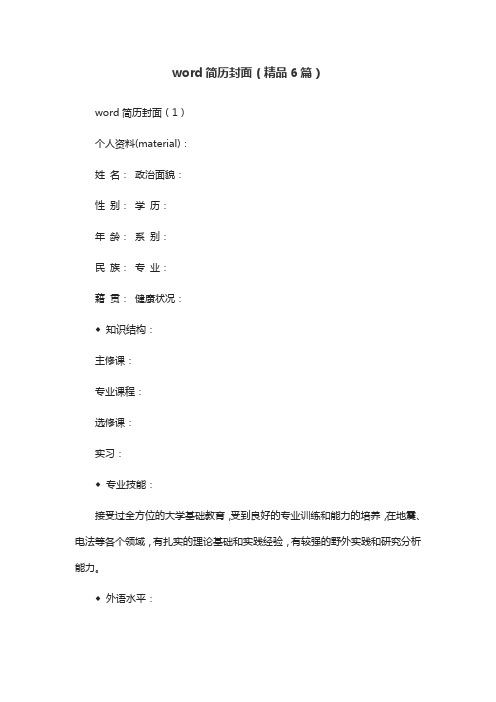
word简历封面(精品6篇)word简历封面(1)个人资料(material):姓名:政治面貌:性别:学历:年龄:系别:民族:专业:藉贯:健康状况:◆知识结构:主修课:专业课程:选修课:实习:◆专业技能:接受过全方位的大学基础教育,受到良好的专业训练和能力的培养,在地震、电法等各个领域,有扎实的理论基础和实践经验,有较强的野外实践和研究分析能力。
◆外语水平:98年通过国家大学英语四级考试。
99年通过国家大学英语六级考试。
有较强的阅读、写作能力。
◆计算机水平:熟悉DOS、Windows98操作系统和Office97、Internet互联网的基本操作,掌握FORTRAN、Quick-Basic、C等语言。
◆主要社会工作:小学:班劳动委员、班长。
中学:班长、校学生会主席、校足球队队长。
大学:班长、系学生会主席、校足球队队长,校园旗班班长。
◆兴趣与特长:☆喜爱文体活动、热爱自然科学。
☆小学至中学期间曾进行过专业单簧管训练、校乐团成员,参加过多次重大演出。
☆中学期间,曾是校生物课外活动小组和地理课外活动小组骨干,参加过多次野外实践和室内实践活动。
☆喜爱足球运动,曾担任中学校队、大学系队、校队队长,并率队参加多次比赛。
曾获吉林市足球联赛(中学组)◆个人荣誉:中学:xxx优秀学生。
xxx优秀团员、三好学生、优秀干部。
xxx英语竞赛三等奖。
大学:校优秀学生干部96、98年度三等奖学金与97年度二等奖学金。
◆主要优点:★有较强的组织能力、活动策划能力和公关能力,如:在大学期间曾多次领导组织大型体育赛事、文艺演出,并取得良好效果。
★有较强的语言表达能力,如:小学至今,曾多次作为班、系、校等单位代表,在大型活动中发言。
★有较强的团队精神,如:在同学中,有良好的人际关系;在同学中有较高的威信;善于协同◆自我评价活泼开朗、乐观向上、兴趣广泛、适应力强、勤奋好学、脚踏实地、认真负责、坚毅不拔、吃苦耐劳、勇于迎接新挑战。
◆求职意向可胜任应用xxx及相关领域的生产、科研工作。
本科大学英语教材封面

本科大学英语教材封面英语教材的封面设计是非常重要的,它不仅仅是一本教材的外观,更是教学内容和理念的象征。
一个精心设计的封面可以吸引学生的注意力,激发学习兴趣,同时还能反映出教材的主题和特点。
下面是一个本科大学英语教材封面的设计示例。
1. 封面背景封面的背景应该选择简洁而纯净的颜色,比如白色或浅蓝色。
这些颜色显得明亮清新,同时也能让文字和图像更加突出。
背景色要与教材的主题相符,比如以大学校园为背景,或以知识、文化为背景。
2. 教材名称教材的名称应该使用大号字体居中显示在封面中央的位置,字体要清晰易读,同时也要能够吸引读者的眼球。
可以使用粗体或者特殊字体来突出教材的重要性和独特性。
3. 作者和出版社在教材名称的下方,可以添加作者和出版社的信息。
作者的姓名可以使用较小的字体,而出版社的名称可以使用稍大的字体,以便读者能够清晰地辨别。
4. 图像和插图教材封面上可以添加图像和插图,以便吸引读者的眼球并展示教材的内容特点。
图像可以是校园风景、学生学习场景或者与教材内容相关的图片。
插图可以是与教材对应的文化背景或者实用的生活场景,以便帮助学生理解和应用所学的知识。
5. 标语和口号在封面上也可以添加一个简短而有吸引力的标语或口号,以概括教材的特点和目标。
标语和口号要简明扼要,能够激发读者的兴趣,同时也要与教材的内容相一致。
6. 辅助元素除了上述主要元素外,还可以在封面上添加其他辅助元素,比如二维码、图书编号或其他相关信息。
这些元素可以增加教材的实用性和互动性,提供给学生更多的参考和学习资源。
总之,本科大学英语教材的封面设计要简洁、明亮、有吸引力。
封面要与教材的内容相一致,能够吸引学生的注意力,激发学习兴趣,同时又能反映出教材的主题和特点。
一个好的封面设计可以提高教学效果,帮助学生更好地理解和掌握英语知识。
通过精心的设计,教材封面能够成为学生学习英语的良好开端。
英语论文格式APA(附:论文模板)

外国语学院本科生英语专业毕业论文装订顺序(APA格式)(注:此格式用于文学、翻译方向之外的所有论文)1.毕业论文封面(汉语)2.毕业论文首页(英语)3.致谢(英文)4.毕业论文中文摘要及关键词5.毕业论文英文摘要及关键词6.目录7.正文8.尾注(可选)9.参考文献(英语文献在前,汉语文献在后)10.附录(可选)附:论文模板(模板内容仅供参考,毕业生可根据实际情况填写)学号:0305114000使用情况调查学 院 名 称: 外 国 语 学 院 专 业 名 称: 英 语 教 育 年 级 班 别: 2002 级 5 班 姓 名: 刘 海 涛 指 导 教 师: 李 庆 东年 月The Use of Linking Adverbials by Chinese College English LearnersA Thesis Submittedto Faculty of International Studies ofHenan Normal Universityin Partial Fulfillment of the Requirementsfor the Degree of Bachelor of ArtsByLiu HiataoSupervisor:Li Qingdong英文年月日enthusiasm, which have been the major driving force to complete the current paper. …无论在口语还是在写作中,中国大学英语学习者在连接副词的使用上都有过多使用的倾向。
影响中国大学英语学习者使用连接副词的因素是多方面的,如母 (linking adverbials in writing and speaking, and give an impersonal description about the non-nativeness that the learners demonstrate in the use of linking adverbials. It is found that Chinese EFL learners have shown an overall overusing tendency in using linking adverbials in their speaking and writing. The results have shown that the factors which contributing to Chinese EFL learners’ use of linking adverbials are multifold, such as mother tongue transfer, pedagogical instructions, stylistic awareness, semantic understanding, pragmatic considerations.Key Words: Linking Adverbials; Chinese EFL learners; Use; TeachingTimes New Roman五号粗体Acknowledgement. . . . . . . . . . . . . . . . . . . . . . . . . . . . . . . . . . . . . . . . . . . . . . . . . . . . . . . . . . . . . . .I . . . . . . . . . . . . . . . . . . . . . . . . . . . . . . . . . . . . . . . . . . . . . . . . . . . . . . . . . . . . . . . . . . . . . . . . .. II Chapter One Introduction. . . . . . . . . . . . . . . . . . . . . . . . . . . . . . . . . . . . . . . . . . . . . . .11.1 Research Background. . . . . . . . . . . . . . . . . . . . . . . . . . . . . . . . . . . . . . . . . . .1 1.2 Motivations and Objectives. . . . . . . . . . . . . . . . . . . . . . . . . . . . . . . . . . . . . . .2 Two The Theoretical Framework of Child Language Learning. . . . . . . . . . . 52.1 Introduction. . . . . . . . . . . . . . . . . . . . . . . . . . . . . . . . . . . . . . . . . . . . . . . . . . 52.2 A Selective Review of Child Learning. . . . . . . . . . . . . . . . . . . . . . . . . . . . . .52.3 Child Language Learning. . . . . . . . . . . . . . . . . . . . . . . . . . . . . . . . . . . . . . 132.3.1 Child First Language Development. . . . . . . . . . . . . . . . . . . . . . . . . . . 14 2.3.2 Child Second Language Development. . . . . . . . . . . . . . . . . . . . . . . . 16 2.3.3 Child Foreign Language Learning. . . . . . . . . . . . . . . . . . . . . . . . . . . . 19 2.4 Summary of Key Learning Principles. . . . . . . . . . . . . . . . . . . . . . . . . . . . . 23 Chapter Three Some Critical Issues in Primary EFL Instruction in Chinese Context. . . . . . . . . . . . . .253.1 Introduction. . . . . . . . . . . . . . . . . . . . . . . . . . . . . . . . . . . . . . . . . . . . . . . . . 25 3.2 The Debate about the Inclusion of English in the Primary Curriculum. . . .25 3.3 The Contents of Primary English Curriculum. . . . . . . . . . . . . . . . . . . . . . . 27 3.4 Approaches to Primary Instruction. . . . . . . . . . . . . . . . . . . . . . . . . . . . . . . .30 3.5 Assessment in Primary English Curriculum. . . . . . . . . . . . . . . . . . . . . . . . 34 Chapter Four Research Design – A Survey Study. . . . . . . . . . . . . . . . . . . . . . . . . . . .374.1 Introduction. . . . . . . . . . . . . . . . . . . . . . . . . . . . . . . . . . . . . . . . . . . . . . . . .37 4.2 The Survey Background. . . . . . . . . . . . . . . . . . . . . . . . . . . . . . . . . . . . . . . .37 4.3 Subjects. . . . . . . . . . . . . . . . . . . . . . . . . . . . . . . . . . . . . . . . . . . . . . . . . . . . 37 4.5 Data Collection and Analysis. . . . . . . . . . . . . . . . . . . . . . . . . . . . . . . . . . . .43 Chapter Five Results and Discussions. . . . . . . . . . . . . . . . . . . . . . . . . . . . . . . . . . . . .455.1 Introduction. . . . . . . . . . . . . . . . . . . . . . . . . . . . . . . . . . . . . . . . . . . . . . . . .455.2 The Overview of Primary EFL Program in Henan Province. . . . . . . . . . . .455.3 The Current Situation of Primary English Classroom Instruction. . . . . . . .52 Chapter Six Conclusion. . . . . . . . . . . . . . . . . . . . . . . . . . . . . . . . . . . . . . . . . . . . . . .696.1 Major Findings and Contributions. . . . . . . . . . . . . . . . . . . . . . . . . . . . . . . .696.2 Recommendations for Future Research. . . . . . . . . . . . . . . . . . . . . . . . . . . .71 Appendixes. . . . . . . . . . . . . . . . . . . . . . . . . . . . . . . . . . . . . . . . . . . . . . . . . . . . . . . . . .73 Bibliography. . . . . . . . . . . . . . . . . . . . . . . . . . . . . . . . . . . . . . . . . . . . . . . . . . . . . . . . . . . . . . . . . . .82河南师范大学本科毕业论文Chapter One Introduction1.1 Research BackgroundIn the first decade 1 or two after World War II, the introduction of foreign languages in the elementary school in the U.S.A.1, and of primary school French in Britain, and similar developments in other countries were part of a widespread search for ways of “improving the effectiveness of language education by taking into account into timetable of language development in childhood” (Stern, 1983, 363). The past decade has seen significant increase in foreign language programs for young learners. In many African and Asian countries, primary children have long been taught French or English as preparation for their use as a medium of instruction.1.2 Motivations and Objectives Times New Roman 五号,1.5倍行距Times New Roman 三号,粗体,居中Times New Roman , 小四号,粗体全文每段首行缩进3-5个字符2.Altenberg, B. (1984). Causal Linking in Spoken and Written English. Studia Linguistica, 38 (pp.20-69).Halliday, M. A. K., & Husan, R. (1988). An Introduction to Functional Grammar: Edward Arnorld.Halliday, M. A. K., & Husan, R. (1970). Language Structure and Language Function. In Lyons (Ed.), Peguin Books (pp. 221-224).Hatch, E. (1992). Discourse and Language Education. London: Cambridge University Press. Quirk, R. et al (1972). A Grammar of Contemporary English. London: Longman.罗瑞球. (2002). 英语习语翻译教学. 湖南师范大学教育科学学报(3).徐其画 & 王乃文. (1989). 实用英译汉教程. 上海: 上海外语教育出版社.杨慧中(主编). (2002).语料库语言学导论. 上海:上海外语教育出版社。
大学英语四六级考试PPT课件

在缺考考生答题卡1和答题卡2上的准考证号填涂
框内,用铅笔靠右填涂缺考考生准考证号的最后 两位,并用签字笔填写考生姓名。
监考流程:
9:55(六级15:55),第二次吹哨,收答题 卡1。提示考生准备接收听力。
10:00 (六级16:00),听力考试正式开始。 (监考教师原则上不允许走动,可制止其他 任何人在听力部分进入考场)听力考试结束 后,考生开始做试题的第四、五、六部分。
四级考试监考员操作规程
9:55 12、收答题卡1。 收卷期间考生不得答题,否则作违规违纪处
理。监考员乙收答题卡1,监考员甲监控整个 考场。
四级考试监考员操作规程
10:00 13、听力考试正式开始。(注:听力时间为35分钟
听力磁带AB双面都有内容) 注:听力部分考试时, 监考员原则上不要走动。若无试题、试题册的原因, 监考员有权制止其他任何人在听力部分考试进行时 进入考场(必须有一名监考员听听力,并记题号, 以便发生故障后从发生故障处开始播放听力)。 14、听力考试结束后,考生开始做试题的第四部分。
四级考试监考员操作规程
考 试 收 尾 收卷 19、监考员按座位号小号在上,大号在下的顺序
(包括缺考考生的答题卡)整理答题卡, 装订密封 20、将整理好的试题册、答题卡1、答题卡2、考场
记录单、考场座次表、磁带一并带到考务办公室, 经考务负责人清点核查无误后密封。 注:①考生的 答题卡1、答题卡2分别装入相应的专用袋内密封 (包括缺考考生)。 ②试题册装入试卷袋内密封 (包括缺考考生)。 六级与四级操作流程相同
装订试卷:
答题卡1、答题卡2、 试卷按编号顺序分别放入 相应的专用袋。
答题卡1、答题卡2、试卷专用袋封面上的各个项 目填写齐全。
大学教案模板封面

封面设计:【封面背景】背景采用淡蓝色渐变效果,寓意清新、宁静的学习氛围。
背景上方配以一幅简约的书籍图案,象征知识的积累与传承。
【封面内容】1. 课程名称- 大字标题:醒目地标注课程名称,如《高等数学》、《大学英语》、《计算机科学基础》等。
2. 授课教师- 小字标题:[教师姓名],以黑色字体清晰呈现。
3. 授课班级- 小字标题:[班级名称],如“计算机科学与技术1班”。
4. 授课学期- 小字标题:[学期名称],如“2023年秋季学期”。
5. 课程编号- 小字标题:[课程编号],如“012345”。
6. 教学目标- 小字标题:教学目标,列出本课程的主要教学目标,如:- 知识目标:掌握[知识点],理解[概念],熟悉[原理]。
- 能力目标:培养学生[能力],提高[技能]。
- 素质目标:增强[素质],形成[品质]。
7. 教学内容- 小字标题:教学内容,简要列出本课程的主要教学内容,如:- 第一章:[内容概述]- 第二章:[内容概述]- 第三章:[内容概述]- ...(根据实际课程内容添加)8. 教学方法- 小字标题:教学方法,介绍本课程采用的教学方法,如:- 讲授法- 讨论法- 案例分析法- ...(根据实际教学需要添加)9. 教学进度安排- 小字标题:教学进度安排,列出本课程的教学进度表,包括每周的教学内容、课时安排等。
10. 参考资料- 小字标题:参考资料,列出本课程的主要参考资料,如教材、参考书籍、网络资源等。
【底部设计】- 底部居中设计一行小字:“本教案模板仅供参考,具体内容请根据实际教学情况进行调整。
”【整体风格】- 整体风格简约、大方,色彩搭配和谐,符合大学课程教案的专业性要求。
【字样字体】- 标题字体:使用微软雅黑或黑体等醒目字体。
- 正文字体:使用宋体或仿宋等易于阅读的字体。
【尺寸要求】- 封面尺寸:A4纸张大小,上下左右留白适当。
通过以上设计,这份大学课程教学设计模板封面既展现了课程的严肃性,又兼具美观性和实用性,为教师的教学工作提供了良好的辅助工具。
大学英语2第五单元ppt课件ppt课件
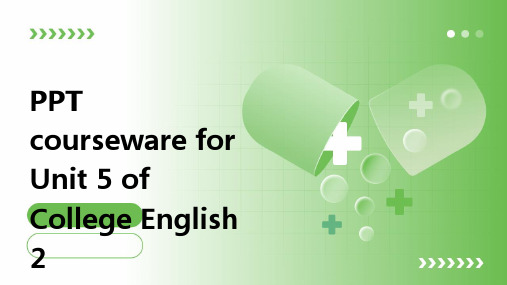
Usage
Forms
Passive voice
This grammar point teaches students how to form sentences that place emphasis on the receiver of an action rather than the performer.
Critical thinking
Encourage students to analyze and evaluate the information they have read, and provide them with opportunities to express their opinions and ideas.
01
Unit Introduction
Knowledge: After completing this unit, students will have a comprehensive understanding of the impact of globalization on the English language. They will be able to identify and explain how globalization has shaped the English language, its vocabulary, and its usage.
In China, people often give red envelopes as gifts, while in the West, people often give flowers or chocolate as gifts. In addition, Chinese people often greet by saying "Have you eaten yet?" while Westerners often greet by saying "How are you?" or "Good morning/afternoon/evening."
全新版大学英语(第二版)综合教程_第五册_Unit 1 Love of Reading——One Writer's Beginnings
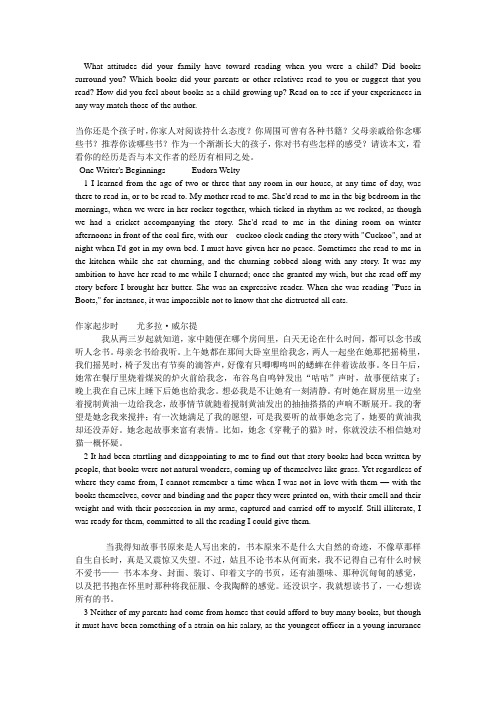
What attitudes did your family have toward reading when you were a child? Did books surround you? Which books did your parents or other relatives read to you or suggest that you read? How did you feel about books as a child growing up? Read on to see if your experiences in any way match those of the author.--------------------------------------------------------------------------------当你还是个孩子时,你家人对阅读持什么态度?你周围可曾有各种书籍?父母亲戚给你念哪些书?推荐你读哪些书?作为一个渐渐长大的孩子,你对书有些怎样的感受?请读本文,看看你的经历是否与本文作者的经历有相同之处。
One Writer's Beginnings Eudora Welty1 I learned from the age of two or three that any room in our house, at any time of day, was there to read in, or to be read to. My mother read to me. She'd read to me in the big bedroom in the mornings, when we were in her rocker together, which ticked in rhythm as we rocked, as though we had a cricket accompanying the story. She'd read to me in the dining room on winter afternoons in front of the coal fire, with our cuckoo clock ending the story with "Cuckoo", and at night when I'd got in my own bed. I must have given her no peace. Sometimes she read to me in the kitchen while she sat churning, and the churning sobbed along with any story. It was my ambition to have her read to me while I churned; once she granted my wish, but she read off my story before I brought her butter. She was an expressive reader. When she was reading "Puss in Boots," for instance, it was impossible not to know that she distrusted all cats.--------------------------------------------------------------------------------作家起步时尤多拉·威尔提我从两三岁起就知道,家中随便在哪个房间里,白天无论在什么时间,都可以念书或听人念书。
英语信封格式范文带翻译13篇
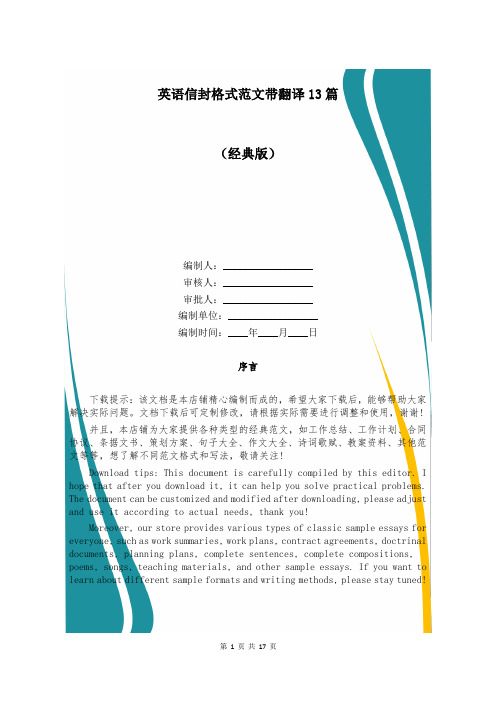
英语信封格式范文带翻译13篇(经典版)编制人:__________________审核人:__________________审批人:__________________编制单位:__________________编制时间:____年____月____日序言下载提示:该文档是本店铺精心编制而成的,希望大家下载后,能够帮助大家解决实际问题。
文档下载后可定制修改,请根据实际需要进行调整和使用,谢谢!并且,本店铺为大家提供各种类型的经典范文,如工作总结、工作计划、合同协议、条据文书、策划方案、句子大全、作文大全、诗词歌赋、教案资料、其他范文等等,想了解不同范文格式和写法,敬请关注!Download tips: This document is carefully compiled by this editor. I hope that after you download it, it can help you solve practical problems. The document can be customized and modified after downloading, please adjust and use it according to actual needs, thank you!Moreover, our store provides various types of classic sample essays for everyone, such as work summaries, work plans, contract agreements, doctrinal documents, planning plans, complete sentences, complete compositions, poems, songs, teaching materials, and other sample essays. If you want to learn about different sample formats and writing methods, please stay tuned!英语信封格式范文带翻译13篇英语信封格式范文带翻译第一篇“时光胶囊心灵慢递”心理协会4月时光胶囊心灵慢递一、活动简介:20XX年我会在哪里?和谁一起?他回来了么?她要走了么?生活会有什么不一样?这些问号的表面被变化覆盖,隐藏在背后的却是对“不变”和所谓“永恒”的暗暗期许我希望我爱的人和地球都还在,而自己还保有最初的棱角和坚持,这些不变就像那件藏在日记本里的小东西让我们永远年轻,永远热泪盈眶。
大学英语教案封面
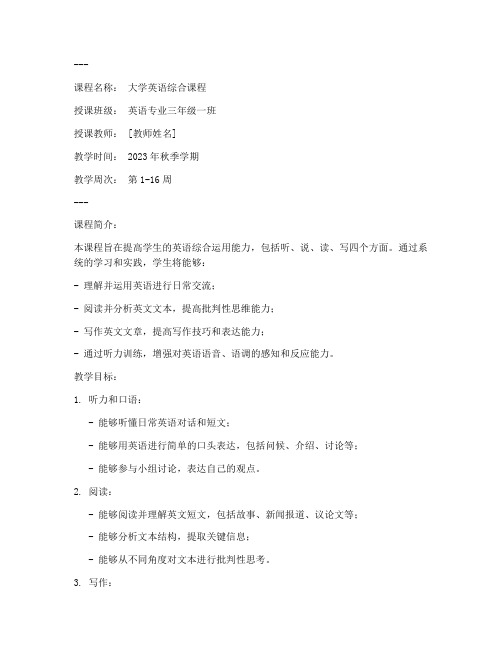
---课程名称:大学英语综合课程授课班级:英语专业三年级一班授课教师: [教师姓名]教学时间: 2023年秋季学期教学周次:第1-16周---课程简介:本课程旨在提高学生的英语综合运用能力,包括听、说、读、写四个方面。
通过系统的学习和实践,学生将能够:- 理解并运用英语进行日常交流;- 阅读并分析英文文本,提高批判性思维能力;- 写作英文文章,提高写作技巧和表达能力;- 通过听力训练,增强对英语语音、语调的感知和反应能力。
教学目标:1. 听力和口语:- 能够听懂日常英语对话和短文;- 能够用英语进行简单的口头表达,包括问候、介绍、讨论等;- 能够参与小组讨论,表达自己的观点。
2. 阅读:- 能够阅读并理解英文短文,包括故事、新闻报道、议论文等;- 能够分析文本结构,提取关键信息;- 能够从不同角度对文本进行批判性思考。
3. 写作:- 能够撰写简单的英文文章,包括描述、叙述、说明和议论; - 能够运用正确的语法和词汇;- 能够组织文章结构,使内容连贯、逻辑清晰。
4. 综合运用:- 能够将听、说、读、写技能综合运用;- 能够在真实语境中运用英语进行有效沟通。
教学内容安排:1. 第一至四周:- 听力训练:日常对话、短文听力;- 口语练习:基础口语表达、日常情景对话;- 阅读理解:短文阅读、信息提取;- 写作练习:简单描述、叙述练习。
2. 第五至八周:- 听力训练:新闻听力、学术讲座;- 口语练习:讨论、辩论、角色扮演;- 阅读理解:长篇阅读、深度分析;- 写作练习:议论文写作、应用文写作。
3. 第九至十二周:- 听力训练:文化讲座、文学作品;- 口语练习:演讲、辩论、角色扮演;- 阅读理解:批判性阅读、文学分析;- 写作练习:论文写作、报告撰写。
4. 第十三至十六周:- 听力训练:模拟考试听力;- 口语练习:模拟面试、情景对话;- 阅读理解:模拟考试阅读;- 写作练习:模拟考试写作。
教学方法:- 互动式教学:通过小组讨论、角色扮演、辩论等形式,提高学生的参与度和积极性。
大学英语阅读进阶答案第四版

大学英语阅读进阶答案(全)第四版(总24页)-CAL-FENGHAI.-(YICAI)-Company One1-CAL-本页仅作为文档封面,使用请直接删除大学英语阅读进阶——第四版PART 1Unit 1 Vocabulary in ContextPractice 1: Examples1.examples:brushing their teeth, washing their hands and facec; B2.examples:the phones were constantly ringing, people were running back andforth, several offices were being painted: B3.examples: the giant land tortoise can live several hundred years; B4.examples: going to town concerts and ball games, visiting neighborhoodfriends, playing board games: A5.examples: gardening, long-distance bike riding ; A6.examples: picking up the language and customs of their new home; A7.examples: a trembling mugging victim, a crying lost child: A8.examples: learning, reasoning, thinking, language: B9.examples: the TV is talking to them, others can steal their thoughts; C10.examples: accepting a bribe from a customer, stealing from an employer; CPractice 2: Synonyms1-5embarrasses; examine; practical; confusing; overlook6-10 necessary; opponents; arrival; charitable; customaryPractice 3: Antonyms1.Antonomy:long; A2.Antonomy: financial loss;B3.Antonomy: openly; B4.Antonomy: plainly; B5.Antonomy: active; A6.Antonomy: clear; C7.Antonomy: benefit; B8.Antonomy: increase in value;B9.Antonomy: careless; B10.Antonomy: weak; BPractice 4: General Sense1-5 B; C; A ;B; C; 6-10 A; C; B; C; BReview Test 11-5context; A; C; B; definition…examplesReview Test 2A.1-5 B; A; B ; C; A;B. 6 D overjoyed; 7 A. provided; 8 C discouraged; 9 E. nag; 10 B.doubtful;Review Test 3A.1-5 practical; clean; reveal; relieve; at the same timeB.6-10 looked down upon; guilty; tried; add to; joined;Review Test 41-5 B; D; D; B; A; 6-10 A; C; D; D; C;Mastery Test 1A:1-3D; B; C;B4-6risk; search; false name;C7-8 C; B;D9-10A; B;Mastery Test 2A1-2 B; A;B3-5plain; conduct; modestC6-7C; C;D8-10D; D; B:Mastery Test 31-5 A; C; C; C ; B;6-10 D; D; C; A; B;Mastery Test 41-5 C; C; A; B; D;6-10 C; A; D; B; CMastery Test 5A: 1-5 C; D; C; A; C;B: (wording of answers may vary.)6 cut off; 7. give a false account of; misrepresent; twist;8. come tetween; get involved; 9. required10 became more forgiving; gave inMastery Test 6A:1. E most common;2. C stir up interest;3. F uncontrolled;4. I increased ;5.B passedB6.I die ;7. D deadly ;8. F be forced to experience;9. E give credit for;10.J reducing2. Main ideasPractice 11.home cooking: Stake-out: Sways to eat dinner: Gfrozen foods: S2.hot and humid: Scold and rainy: Scloudy with scattered showers: Sweather forecasts: G3.oversleeping: Sbad habits: Govereating: Ssmoking: S4.traffic delays: Shead cold: Sbad coffee: Sminor problems: Gmunicating: Gwriting: Sreading: Sspeaking: S6.deadbolt locks: Salarm system: Sbarking dog: Skinds of security: G7.divorce: Sfailing grades: Smajor problems: Geviction: S8.not taking notes in class: Spoor study habits: Gmissing classes: Scramming for exams: S9.surprised: Stone of voice: Genthusiastic: Shumorous: S10.hurry up: Sget to bed: Scommands: Gclean up this mess: SPractice 2Answers will vary.Practice 31.P S S S2.S S P S3.S S S P4.P S S S5.S P S SPractice 41.S S P S2.P S S S3.S P S S4.S P S S5.S S S PPractice 51.S S P S2.S P S S3.P S S S4.S S S P5.P S S SPractice 6Group1A. SDB. SDC. MID. TGroup 2A.MIB. SDC. SDD. TGroup 3A.TB. SDC. SDD. MIGroup 4A.MIB. SDC. SDD. TGroup 5A.MIB. SDC. TD. SDPractice 7 (wording of topics may vary) 1.Topic: StoriesMain idea: Sentence 12.Topic: ESPMain idea: Sentence 23.Topic: Hospices vs hospitalsMain idea: Sentence 24.Topic: Driving or Poor attitude about drivingMain idea: Sentence 105.Topic: Environment and behaviorMain idea: Sentence 1Practice 81.12. 43. 24. 55. 1Review Test 11. B2. B3. A4. A5. other sentences in the paragraphReview Test 2A. 1. a. S b. S c. S d. P2. a. S b. S c. P d. SB. 1. a. SD b. SD c. T d. MI2. a. SD b. SD c. T d. MIReview Test 31. 32. 13. 94. 25. 2Review Test 41. D2. C3. A4. A5. C6. C7. A8. D9. A 10. A Mastery Test 1A. 1. a. S b. P c. S d. S2. a. P b. S c. S d. S3. a. S b. S c. S d. PB. 1. a. SD b. T c. SD d. MI2. a. MI b. SD c. T d. SDMastery Test 2A. 1. a. S b. P c. S d. S2. a. S b. S c. P d. S3. a. P b. S c. S d. SB. 1. a. SD b. SD c. T d. MI2. a. MI b. T c. .SD d. SDMastery Test 31. 12. 23. 64. 15. 2Mastery Test 41. 32. 23. 14. 75. 2Mastery Test 51. 62. 43. 24. 15. 2Mastery Test 61. 2. 2. 1 3. 2 4. 3 5. 11Unit 3. Supporting DetailsPractice 1. ( wording of answers may vary)1.Main idea: Parents can take several steps to discourage TV watching andencourage reading.1.Have only one TV set, and place it in the family room.2.Connect reading with eating.3.Don’t put a TV set in a child’s bedroom.2.Main Idea: Colleges of the early nineteenth century were distinctlydifferent from today’s schools.1.students were mostly white males.Minor details: College was considered a final polishing for upper-class gentlemen.2.All students had to take the same courses.Minor details: They studied ancient languages, literature, naturalscience, mathematics, and political and moral philosophy.3.Colleges were small.Minor details: Most had only a few dozen students, three or fourprofessors, and three or four tutors.4.Student life was more regulated.Minor details: Strict curfews determined when students had to turn offlights, and attendance at religious services was required.Practice 2 ( Wording of answers may vary )1.Introduce yourselfRefer to physical settingAsk a complimentary questionSeek direct information2.Major detail: Smaller labor forceMinor detail: Milking machines use only one operator.Major detail; Higher milk outputMinor detail: American cows give 7.5 times more milk than Brazilian cows. Practice 31.C2.BPractice 4 ( Examples may vary )1.Passive listening—trying to make sense out of a speaker’s remarks withoutbeing able to interact with the speaker.Ex—Students listen to an instructor’s lecture without having the chance to ask questions.2.Self-serving bias—the practice of judging ourselves leniently.Ex—When he lashes out angrily, we say he’s moody. When we lash outangrily, we say we’re under pressure.Review Test 11. specific…specific2. T3. supporting details4. mapping5. condenseReview Test 2A.Main idea: Several factors influence the justice system’s treatment ofcriminals.1.Sex of offender affects severity of sentence.b. Court more reluctant to send mother to prison than father2. Race is another factora. Nonwhites awarded parole and probation less often .b. Blacks executed more often for capital crimes.3. a. Young offenders given special treatment.B. 8. C 9. C 10. BReview Test 3A.Main idea: Serious depression has definite warning signs.1.Change in sleep patterns2.Abnormal eating patterns3.Trouble in thinking or concentrating4.General feeling of hopelessnessB.Main idea: There are three common ways that people deal with their feelings.1)withhold them2)Display them3)Describe themC.10. CReview Test 41-5 : B; A; D; A; long interviews6-10A. 1. Basic temperament the child is born with.2. Early emotional environmentB. 1. Authoritative 2. Authoritarian 3. PermissiveMastery Test 1A.Main idea: Divorce has serous negative consequences.1. a. Starting to date again can be nerve-racking.2.Emotional difficulties among original family members are common.a.Husband and wife feel guilt and resentment.3.Financial adjustments are necessary.a.Alimony, child support, and property disposal must be dealt with.B. 7. B 8. A 9. C10. They can undo complicated bolts on gates.Mastery Test 2A. 1.B; 2. D; 3. C; 4. D; 5. C; 6.B;B.Main idea: Chimpanzees use objects in their environment as tools.1.Sticks to catch termites and steal honey.2.Leaves as drinking cups, for cleaning, and as spongers3.Stones to crack open nuts.Mastery Test 3.A.1-6 A; B; A; D; B; AB.Main idea: Three types of human memory allow us to remove or keepinformation as needed.1.Sensory memory2.short-term memory—stores about 7 items for about 30 seconds.3.Long-term memory—stores enormous numbers of items for a long period.Mastery Test 4A . Main idea: Researchers have created a number of theories to explain the functions of sleep.1. Gives body time to repair brain cells and create chemical that makes brain think.2. Enables body to save energy3. Keeps people out of trouble.4. Reduces memoryB. 6. CC. 7-10 A; B; B; D;Mastery Test 5A.1-5 B; D; A; B; C;B.Main idea: Experts in our country have suggested various purposes ofimprisonment.1)Punishnent2)Rehabilitation3)Deter crime4)Keep criminals off streetsMastery Test 6A. 1. a. 2) Informal and friendly atmosphere in the Senateb. Procedural differences1)House rules—many and complex2)Senate rules—short and simple2.Political outlook of membersa. Representatives concerned with local issuesB.Main idea: A number of conditions stimulate aggression.1) Pain2) Attacks3) Crowding4. Implied Main idea/Central PointPractice 1Paragraph 1: 1 D 2A Paragraph 2: 3C 4B Paragraph 3: 5C 6BParagraph 4: 7D 8BPractice 21D 2B 3C 4CPractice 3 (Wording of answers may vary.)1. Topic: Reasons for lyingImplied main idea: People tell lies for several reasons.2. Topic: Being an only childImplied main idea: Being an only child has its drawbacks.3. Topic: Opposition to capital punishmentImplied main idea: People have opposed the death penalty for different reasons.4. Topic: Growing olderImplied main idea: Growing older can make us better in many ways.Practice 4Central point: In fact, the days of a housewife in nineteenth-century America were spent in harsh physical labor. (Sentence 2)Practice 5Central point: However, excessive use of alcohol contributes to a number of negative social consequences. (Sentence 2)Review Test 11. implied2. topic3. support4. central point5. sometimesReview Test 2A. 1B 2AB. 3. Watching TV has several benefits.4. Lower-class criminals tend to be treated more harshly by the justice system than higher-class criminals. (In all these tests, wording of implied main ideas may vary.)Review Test 3A. 1B 2DB. 3. Several techniques can help you get a good night’s sleep.C. 4. Sentence 6Review Test 41B 2C 3A 4A 5D 6A 7C 8A 9D 10BMastery Test 1A. 1C 2A 3DB. 4. Sentence 1Mastery Test 2A. 1C 2B 3DB. 4. Sentence 20Mastery Test 3A. 1A 2A 3DB. 4. Sentence 19Mastery Test 4A. 1D 2BB. 3. There are several positive ways to encourage your family to exercise more often.C. 4. Sentence 16Mastery Test 5A. 1D 2DB. 3. Experts have suggested several techniques for doing well on exams.C. 4. Sentence 3Mastery Test 6A. 1D 2BB. 3. Marriage is good for people’s physical and mental health.C. 4. Sentence 10Unit 5 relationships IPractice 1 (Answers may vary)1.also 2. For one thing 3. In addition 4. First 5 .FinallyPractice 2 (Answers may vary)1 After2 Then3 during4 before5 whilePractice 3 (Wording of answers may vary)A Main idea: For several reasons, pork was America’s popular meat a hundred year ago.1 Pigs grew quickly2 Pigs required little attention3 Pigs could be preserved cheaplyB Main idea: …aging process1 Our bodies simply wear out.2 Our body chemistry loses its delicate balance4 Our bodies, with age, reject some of their own tissues.Practice 4 (Wording of answers may vary)Main idea: The 1960s were a time of profound events in America.1. 1963 – the assassination of President Kennedy2 1965 – urban riots in black ghettos3 1968 – protests against increasing American presence in VietnamPractice 5 (Wording of answers may vary)Main idea: People pass through three stages in reacting to unemployment.1 Shock followed by relief2 Strong efforts to find a new job3 Self-doubt and anxiety if no job is foundPractice 6 (wording of answers may vary)Main idea: Taking certain steps will help you to remember your dreams.2 Put a pen and notebook near your bed.3 Turn off alarm so you can wake up gradually.4 Write down the dream immediatelyPractice 71B 2A 3A 4B 5B 6A 7A 8B 9A 10BReview Test 11 the relationships between2 addition3 time4 T5 supporting details Review Test 2A. 1 E before 2 C also 3 D one 4 A then 5 F final 6 B secondB. 7 B 8 after 9 A 10 alsoReview Test 3A. 1 After 2 First 3 Then 4 As 5 later 6 BB.7 B 8A 9 B 10 AReview Test 41 B2 D3 B4 A5 A6 C7 first, another, final8 A9 finally 10 BMastery Test 1A 1 A Another 2 E When 3 C also 4B Then 5 D NextB 6 after 7 next 8 Last 9 then 10 BMastery Test 2A 1 A When 2 D First 3B Moreover 4C Before 5 E alsoB 6 BC 7 First 8 also 9 Finally 10 AMastery Test 3A 1-5 3, 1, 4, 2, AB 6 BC 7 A8 -10 Main idea: Prevention against injury involves a combination of two types of preventive measures.1 Active prevention – methods that require people to do something to reduce the risk of injury.2 Passive prevention- methods requiring little or no action on the part of those being protected.Mastery Test 4A 1-4 4, 1, 3, 25 BB 6 BC Main idea: Work shapes human lives in fundamental ways- Consumes enormous amounts of time-Gives life structure and rhythm-causes stressMastery Test 5A. 1 B 2 early (or later or eventually or next)B. 3 A 4 CC. 5 B6-10 Denial-Anger-Depression-Bargaining-AcceptanceAcceptance DenialBargaining AngerDepressionMastery Test 6A 1 B2-3 Any two of the following: first, next, third, finallyB 4 A 5 also 6 AC 7 A8-10 Main idea: Children learn their gender roles in three main ways.2 Imitation3 Self-definitionUnit 6 Relationships IIPractice 1 (Answer may vary)1 For instance2 for example3 such as4 including5 illustrationPractice 2A Shaping; definition — 1; example 1—2 example 2—10B Irony—saying one thing but meaning anotherEx—To end the famine in Ireland, Swift suggests the Irish should raise babies to be eatenPractice 3 (Answer may vary)1 Similarly2 Just like3 in the same way4 as5 Just asPractice 4 (Answer may vary)1 however2 Although3 but4 despite5 In contrastPractice 5A Contrast: Japanese employment practices and US employment practicesB Contrast: school and homePublic discipline Private scolding Much competition Minimal competition Practice 6 (Answer may vary)1 Because2 as a result3 so4 Since5 ThereforePractice 7A.Cause: Chronic stressEffect: Painful muscle tension Effect: Weakening of body’s immune systemEffect: Psychological disordersB.Main idea(effect): There are several reasons that people daydreamMajor supporting details ( causes):1.To tolerate boring jobs2.To endure deprivation3.To discharge hostile feelings4.To plan for the futurePractice 81A 2C 3B 4C 5A 6B 7C 8A 9C 10BReview Test 11 examples2 comparison3 contrast4 C5 CReview Test 2A. 1 B effects 2 C just like 3 E However 4A Because 5D such asB. 6B 7C 8A 9C 10AReview Test 3A 1 A 2 for instanceB 3C 4 alike or but or while or in contrastC 5B 6 because or as a result or effectD 7A 8 exampleE 9 B 10 affected or because or resultReview Test 41B 2C 3C 4B 5A 6B 7C 8A 9B 10DMastery Test 1A 1 B. For example 2 C. Just as 3 A. Therefore 4D. Because 5E. In contrastB 6A 7C 8A 9B 10CMastery Test 2A. 1B 2 reason or as a resultB. 3C 4 in contrastC. 5A 6 for exampleD. 7B 8 causing or since or leads to or causesE. 9C 10 different or contrasts or nevertheless or same or alike or similar Mastery Test 3A 1-4 3, 2, 4, 15CB 6C 7 differently or in contrast or whileC 8D 9A 10 exampleMastery Test 4A. 1-4 4, 1, 3, 2 5AB. 6A 7B 8 as the resultC. 9B 10CMastery Test 5A 1B 2-5 Learn to do their jobs betterGet a raise or promotionLearn a new fieldLearn for the sake of learningB 6B 7-10 Good manager4 is flexiblePoor manager1 Is surprised by problems3 Takes on extra tasks4 Clings to old rulesMastery Test 6A 1C 2-6 DelaysLack of resourcesLossesFailureDiscriminationB 7B8-10 Main idea: Role conflict—a situation in which the different roles an individual is expected to play make incompatible demands.—For a working mother, the expectations of motherhood may conflict with those of a full-time job.—For a priest, the responsibility to treat confessions confidentially may conflict with his responsibility to the community.7. Fact and OpinionPractice 1A. 1. F 2. O 3. O 4. F 5. FB. 6. O 7. O 8. F 9. F 10. OPractice 2Answers will vary.Practice 3A. 1. O 2. F 3. F+O 4. F+O 5. FB. 6. F 7. O 8. F 9. F+O 10. OPractice 4A. 1. F 2. F+O 3. F 4. F 5. F+OB. 6. F 7. F+O 8. F 9. F+O 10. F+OPractice 5A. 1. F 2. O 3. F 4. O 5. F+OB. 6. F 7. F 8. F 9. F+O 10. F+OPractice 6A. 1. F 2. F+O 3. F 4. F+OReview Test 11. A fact2. A news report3. a mixture of fact and opinion4.Opinions5.enjoyableReview Test 2A. 1. F 2. O 3. F 4. OB. 5. F+O 6. F+O 7. F 8. F+OC. 9. F 10. F+OReview Test 3A. 1. O 2. F 3. F+O 4. F 5. F+O 6. O 7. F 8.F 9. O 10. F+OB. 1. 1. F+O 2. F 3. O 4. F 5. O2. 1. O 2. F3. F4. F+O5. OMastery Test 1A. 1. F 2. O 3. F 4. O 5. O 6. F 7. F 8. O 9. F 10. OB. 11. F+O 12. F 13. F+O 14. F 15. F+OC. 1. F 2. F+O 3. F 4. O 5. OMastery Test 2A. 1. O 2.F 3. O 4. F 5. F 6.O 7. O 8. F 9. O 10. FB. 11. F+O 12. F 13. F+O 14. F+O 15. FC. 1. F 2. F+O 3. F 4. O 5. OMastery Test 3A. 1. F 2.O 3. F 4. F+O 5.O 6.F 7. F 8. O 9. F 10. F+OB. 11. F+O 12. F 13. F+O 14. F 15. F+OC. 1. O 2. F 3. F 4. F+O 5. OMastery Test 4A. 1.O 2.F+O 3. O 4. O 5.F 6.F+O 7. F 8. F 9. F 10. F 11. F12. OB. 1. F+O 2. O 3. F 4. F 5. FC. 18. F 19. F+O 20. OMastery Test 5A. 1. O 2.F 3. F+O 4. O 5.F 6.F 7. O 8. F 9. F 10. F 11. O12. F+OB. 1. O 2. F+O 3. FC. 16. F+O 17. F 18. F 19. O 20. F+OMastery Test 6A. 1. F 2.F 3. O 4. F 5.F+O 6.F 7. F 8. O 9. F+O 10. OB. 1. F 2. F 3. F+O 4. F 5. F+OC. 16. F 17. F 18. F+O 19. O 20. F8.InferencesPractice 1 Practice 2 Practice 3 Practice 41. C A.1.C B.5.C C.9.B A.3,4,6 1.Simile,B2. D 2.B 6.B 10. A B.1,4,6 2.Simile,C3. D 3.C 7.A 11. B. C.1,4,6 3.Metaphor,B4. B 8.C 12. B. 4.Metaphor,C5.Metaphor,C Practice 5 Practice 61. B 6. B 2,5,62. B 7. A3. C 8. A4. C 9. C5. A 10. BReview Test 1 Review Test 2 Review Test 31. suggested 4. T A. 1,3,5,7 A.1,3,5,6eful 5.tell…show B. 2,4,6,7 B.5,A 8.Aeful C. 1,2 6.A 9.A7B 10CReview Test 41 B 6 .A2. D 7. B3. C 8. D4. C 9. D5. A 10. BMastery Test 1 Mastery Test 2 Mastery Test 3A.1,4,6 A.1. C 3. A A. 1. A 3. CB.2,3,4 2. B 4. C 2. B 4. AC.1.2,5 B.2,4,5,6,8,10 B.4,52.1,5 C.1,3.5,8Mastery Test 4 Mastery Test 5 Mastery Test 6A.1.CB. 6. A A. 2,3,5,6 A. 1. C B. 6. B2.C 7. A B. 5. A 2. B 7. A3.C 8.C 6. B 3. B 8. C4.B 9.B 7. C 4. C 9. A5.A 10.B 8. C 5. A 10.A9. A10. BUnit 9Practice 11. P2. I3. P4. I5. E6. E7. P8. I9. E 10. IPractice 21. B2. C3. APractice 31. C2. A3. E4. D5. BPractice 31. C2. A3. E4. D5. BPractice 4A. 1. admiring 2. sympathetic 3. critical 4. objective 5. ironicB. 6. straightforward 7. sarcastic 8. threatening 9. self-pitying 10. sympatheticPractice 51. F2. I3. C4. B5. EPractice 61. B2. A3. B4. A5. BReview Test 11. purpose2. inform3. entertain4. persuade5. attitude6. opposite7.B 8.C 9. C 10. BReview Test 21.P2. I3. E4. I5. PReview Test 31. C2. E3. B4. D5. HReview Test 41. D2. C3. B4. A5. D6. B7. B8. B9. A 10. CMastery Test 1A. 1. I 2. P 3. E 4. P 5. EB. 6. D 7. B 8. E 9. C 10. AMastery Test 2A. 1. I 2. P 3. E 4. I 5. P 6. I 7. PB. 8. C 9. E 10. AMastery Test 3A. 1. B 2. H 3. F 4. I 5. D 6. J 7. CB. 8. I 9. P 10. EMastery Test 4A. 1. E 2. A 3. I 4. C 5. G 6. F 7. JB.8. IC.9. A 10. BMastery Test 5A. 1. B 2. CB. 3. A 4. DC. 5. B 6. DD.7. C 8. DMastery Test 6A. 1. A 2. AB. 3. A 4. BC. 5. B 6. AD.7. A 8. D10. ArgumentPractice 11. A. S B. P2. A. S B. P3. A. S B. P C. S4. A. P B. S C. S5. A. S B. P C. S6. A. S B. P C. S7. A. S B. P C. S8. A. S B. P C.S D. S9. A. P B. S C. S D. S 10. A. S B. S C. PPractice 21. A, C, F2. C, E, F3. A, D, F4. A, C, F5. B, D, EPractice 31. B2. BPractice 41. C2. APractice 51. B2. CPractice 61. B2. DReview Test 11. C2. A3. C4. B5.DReview Test 2A. 1.B 2.B 3.D 4.CB. 5.B 6.D 7.E 8.A 9.D 10.FReview Test 3A. 1.C 2.A 3.DB. 4.D 5.CReview Test 41.C2.D3.C4.C5.D6.A7.A8.C9.B10. A.S B.P C.X D.SMastery Test 1A. 1.A 2.D 3.B 4.AB. 5.A 6.D 7.E 8.B 9.D 10.EMastery Test 2A. 1.C 2.C 3.BB. 4.A 5.D 6.E 7.A 8.C 9.FC. 10.DMastery Test 3A. 1.C 2.B 3.DB. 4.D 5.BMastery Test 4A. 1.A 2.D 3.AB. 4.C 5.DMastery Test 5A. 1.A 2.D 3.F 4.B 5.C 6.FB. 7.CC. 8.A 9.B 10BMastery Test 6A. 1.B 2.D 3.F 4.B 5.C 6.FB. 7.CC. 8.A 9.B 10.APART2 十篇精选Answers to the Reading Selections 1-51 The Yellow RibbonSkills Questions1. A2. B3. D4. B5. F6. B7. D8. B9. C 10. D11. D 12. C 13. C 14. B 15. T 16. C 17. C 18. C 19. A 20. CSummarizing B2. Urban LegendsSkills Questions1. D2. A3. D4. C5. A6. D7. A8. B9. C 10. D11. A 12. A 13. A 14. C 15. B 16. D 17. A 18. B 19. C 20.BMappingWhat they areGather more realistic details and variations as they travelThe playboy’s carThe cement-truck driver’s revenge3. ShameSkills Questions1. C2. D3. C4. A5. D6. T7. B8. C9. D 10.C 11. B 12. B 13. B 14. F 15. C 16. T 17. T 18. D19. T 20. AOutlining1. Becomes ashamed of his povertyb. Is humiliated by teacherc. Leaves school and avoids it in the future2. Becomes ashamed of his own failure to help anotherc. Offers to pay for meal, but too late4. The Bystander EffectSkills Questions1. C2. D3. B4. D5. D6. D7. C8. D9. C 10.D11. A 12. D 13. D 14. A 15. C 16. D 17. B 18. C 19. C20. BSummarizing (Note: Wording of answers may vary.)witnesses presentno one called the police during the attackthe reactions of bystanders to emergenciesinterpretis felt by each member of the crowd5. The Real Story of Flight 93Skills Questions1. D2. B3. B4. A5. F6. C7. A8. A9. D 10.C11. B 12. A 13. B 14. D 15. D 16. D 17. A 18. C 19. B 20.DOutlining1. Introduction—paragraphs 1 to 4a. Lisa Beamer’s conversations with counsellor and Airfone supervisor2. Narrative of the events of Flight 93—paragraphs 5 to 313. Conclusion—paragraphs 32 to 33a. Lisa Beamer as hero’s widowb. Teddy Roosevelt’s words6 COPING WITH NERVOUSNESSSkills Questions1. C2. B3. B4. A5. C6. C7. B8. C9. B 10. D11. A 12. A 13. A 14. A 15. A16. D 17. D 18. C 19. A 20. AOutliningB. People can learn to cope with the fear of public speaking.C. There are various ways to cope with your nervousness about public speaking.2. Prepare adequately for your speech.4. Use coping methods for walking to the speaker’s stand and just after.7 COMPLIANCE TECHNIQUESSkills Questions1. C2. D3. A4. A5. B6. C7. D8. D9. C 10. A11. C 12. D 13. C 14. A 15. C16. B 17. D 18. F 19. B 20. CSummarizing (Note: Wording of answers may vary.)2. … making a smaller request. The first request is so outrageously largethat people might be tempted to slam the door in the requester’s face.Example: … to give a great deal of time.3. asking a person to agree to something on the basis of incompleteinformation and then later telling the full story.4. Example: At a bake sale, customers were more likely to buy cupcakes for75 cents if they were told they would also get two free cookies.8 LIZZIE BORDENSkills Questions1. C2. C3. C4. A5. B6. A7. C8. D9. B 10. C11. B 12. A 13. A 14. C 15. C16. C 17. A 18. B 19. D 20. BSummarizing: B9 NONVERBAL COMMUNICATIONSkills Questions1. B2. B3. C4. D5. A6. A7. D8. B9. D 10. C11. C 12. B 13. A 14. T 15. B16. A 17. B 18. A 19. B 20. DOutlining (Note: Wording of answers may vary.)A. Nonverbal messages: the use of personal space3. Social distance4. Public distanceB. 2. a. Helps communicate certain emotions, attitudes, and preferencesb. Supports our verbal communications10 PREDINDUSTRIAL CITIESSkills Questions1. C2. B3. B4. B5. A6. B7. T8. C9. A 10. C11. C 12. A 13. B 14. B 15. D16. A 17. A 18. D 19. B20. Preindustrial cities were more crowded (or dangerous or disease-ridden) MappingDisease limited size of cityPopulation densityReasons people were Cause 2:attracted to them Not being able to expand upwardOpportunity to start a new lifePART3 拓展学习Combined-Skills TestsTest 11 C2 C3 A4 A5 B6 C7 D8 DTest 21 B2 D3 B4 B5 A6 B7 A8 CTest 31 B2 D3 C4 B5 D6 A7 B8 ATest 41 B2 B3 A4 C5 A6 C7 A8 DTest 51 B2 C3 C4 D5 B6 D7 C8 BTest 61 D2 A3 A4 B5 B6 A7 A8 CTest 71 B2 A3 D4 C5 D6 B7 C8 DTest 81 D2 D3 B4 D5 C6 A7 D8 CAnswer Sheet: Combined-Skilled Tests ( 9—15)Test 91. A2. B3. B4. D5. C6. B7. C8. BTest 101. C2. C3. B4. B5. C6. C7. D8. DTest 111. C2. D3. C4. C5. A6. B7. A8. CTest 121. C2. B3. C4. A5. C6. A7. C8. BTest 131. C2. B3. A4. C5. B6. A7. D8. BTest 141. B2. D3. A4. C5. A6. A7. B8. ATest 151. A2. C3. A4. C5. A6. D7. C8. AAnswers to the Practices and Tests in Part III2 PropagandaPractice 1: 2, 5Practice 2: 2, 4Practice 3: 2, 3Practice 4: 1, 5Practice 5: 2, 4Practice 6: 1, 5Practice 7: 1. B 2. A 3. CReview Test 1: 1. B 2. A 3. A 4. A 5. BReview Test 2: 1. D 2. A 3. A 4. D 5. C 6. C 7. B 8. D 9. A 10. A Review Test 3: A. 1. B 2. D 3. C 4. C 5. C 6. B 7. A 8. DB. 9. B 10. C。
大学英语综合教程BOOk5Unit1

Ring Lardner
• full name Ringgold Wilmer Lardner (1885-1933), American writer and humorist, born in Niles, Michigan. From 1907 to 1919 he was a newspaper columnist and sports reporter. He first attracted attention with a series of humorous magazine stories about a young baseball player, eventually published as You Know Me, Al (1916). In Treat ‘Em Rough (1918) and The Big Town (1921), Lardner depicted the lives of ordinary Americans with satirical humor.
sob: draw in breath sharply and irregularly from
sorrow or pain, esp. while crying; make a sound like that of sobbing
• I found her sobbing in the bedroom because she’d broken her favorite doll. • You’re not going to help matters by lying there sobbing! • She began to sob again, burying her face in the pillow. • n. act or sound of sobbing • I could hear her sobs from the next room. • Her body shook with sobs. • sob out one's grievances ['ɡri:vəns] n. 不满,不平;委屈 • 哭着诉苦
全新版大学英语综合教程
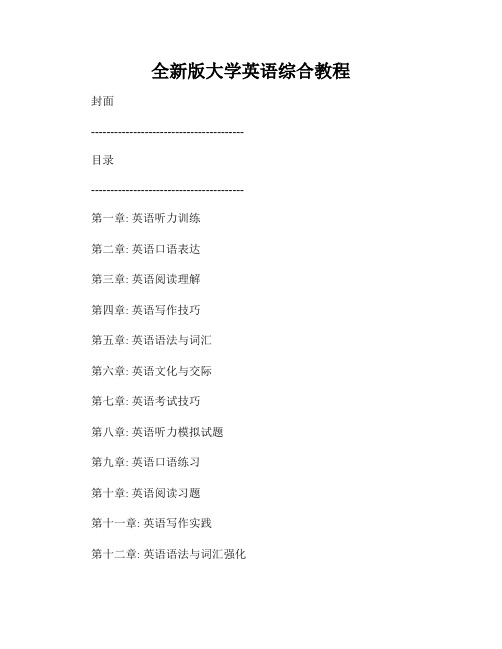
全新版大学英语综合教程封面----------------------------------------目录----------------------------------------第一章: 英语听力训练第二章: 英语口语表达第三章: 英语阅读理解第四章: 英语写作技巧第五章: 英语语法与词汇第六章: 英语文化与交际第七章: 英语考试技巧第八章: 英语听力模拟试题第九章: 英语口语练习第十章: 英语阅读习题第十一章: 英语写作实践第十二章: 英语语法与词汇强化第十三章: 英语文化与交流技巧第一章: 英语听力训练----------------------------------------英语听力训练是学习语言的重要一环。
通过听力训练,学生能够提高自己听力理解力,培养对于语音、语调的敏感度。
在这一章中,我们将学习如何有效地进行英语听力训练,包括提高听力速度和准确度的技巧,并提供一些实用的听力练习材料。
第二章: 英语口语表达----------------------------------------英语口语表达是学习语言的重要组成部分。
通过口语表达,学生能够提高自己的口语流利度和表达能力,培养自信心。
在这一章中,我们将学习如何有效地进行英语口语训练,包括提高口语表达能力的技巧,并提供一些实用的口语练习材料。
第三章: 英语阅读理解----------------------------------------英语阅读理解是学习语言的关键能力之一。
通过阅读理解,学生能够扩展自己的词汇量和阅读理解能力,提高对于语言文化的理解。
在这一章中,我们将学习如何有效地进行英语阅读理解训练,包括提高阅读速度和理解能力的技巧,并提供一些实用的阅读材料。
第四章: 英语写作技巧----------------------------------------英语写作技巧是学习语言的关键技能之一。
通过写作技巧的学习,学生能够提高自己的写作能力和表达能力,培养逻辑思维和组织能力。
ZUCC大学英语5 Quiz six答案

Z U C C大学英语5Q u i z s i x答案(总10页)-本页仅作为预览文档封面,使用时请删除本页-问题 1 1 分 保存The rainstorm has damaged the crops. The loss has not yet been__________ accurately, but it is believed to be well beyond a million dollars.A. consideredB. assessedC. exploredD. calculated问题 2 1 分保存Although Wilmut maintains that cloning (克隆) animals has__________ potential for helping people, many people are still worried about it.A. tremendousB. insignificantC. exclusiveD. complex问题 3 1 分保存The people __________ in social dancing for their own pleasurerather than for the entertainment of an audience.A. trainB. attendC. practiceD. participate问题 4 1 分保存“Did your employer pay for the notebook comput er and the mobilephone for you” “No, I bought them at my own __________.A. incomeB. payC. costD. expense问题 51 分保存tense in English.A. similarB. comparativeC.equivalentD.identical问题 6 1 分保存The latest model of the Buick, __________ by the GM, is highlysought after by lots of young people here this year.A. engravedB. accomplishedC. manufacturedD. modified问题 7 1 分保存You can’t just do it however you like – you must follow the__________.A. processB. procedureC. programD. project问题 8 1 分保存Not long after they crossed the Continental Divide, __________before them was the most beautiful sight of the whole trip – theTetons.A. stretched outB. extended outC. expanded outD. prolonged out问题 9 1 分保存people of the United States suffer from government, national, stateand local, which is corrupt and __________.A. incredibleB. initiativeC. indifferentD. inefficient问题 10 1 分保存You should __________ the worn and sleazy paint from the wallbefore you decorate the room.A. stringB. stripC. stripeD. strive问题 11 1 分保存The tests themselves are merely methods with characteristics that canbe measured with reasonable __________ under specifiedcondition.A. activityB. abilityC. precisionD. possibility问题 12 1 分保存Motivation is some kind of __________ drive that encouragespeople to pursue a course of action.A. fatalB. internalC. externalD. final问题 13 1 分保存The legislative branch, one of the three branches of America’sgovernment system, contains the two houses of __________ -- theHouse of Representatives and the Senate.A. CouncilB. ConstitutionC. CongressD. Conference问题 14 1 分保存After I have gone, remember never to let the flies __________ yourfood before you eat it; and do not sleep on the ground when therains are coming.A. settle onB. settle downC. settle upD. settle in问题 15 1 分保存Sir Win is a respected banker. But he has been criticized by someboard directors for failing to guide and __________ Vikram Pandit,a first-time chief executive.A. suspectB. superviseC. replaceD. expose问题 16 1 分保存 Although sexual and violent crimes have increased by 10%, theyremain only tiny __________ of the total number of crimescommitted each year.A. rateB. ratioC. fractionD. aspect问题 17 1 分保存Stamp-collecting, once __________ the hobby of small boys and anall-consuming passion for older enthusiasts, has now become thetarget of financial speculators.A. exclusivelyB. eventuallyC. completelyD. financially问题 18 1 分保存The post-war government had the enormous task of __________ thecountry’s economy.A. reversingB. renewingC. reconstructingD. reducing问题 19 1 分保存Because of the heavy storm, the ship did not __________ untilmidnight.A. get off toB. get down toC. get on forD. get under way问题 20 1 分保存Jim Thorpe, an American Indian, was almost __________ chosenthe most outstanding athlete of the half-century in a poll held by theAssociated Press.A. unpredictablyB. unanimouslyC. unfortunatelyD. universally问题 2110 分保存The Risk Identification Workshop on SYSTEM Z Redesign Phaseis planned to be held_________ in Room 701,Tower C, on Monday morning from 9:00 to 11:00, October 24.There will be 8 attendees,including _________Chairman Jack Smith, and Jim Whitney who will be the keynotespeaker of the workshop. The agendaitems_________ are the following: First, Chairman Jack Smith’s 5-min introduction_________ of reviewingpurpose of workshop. Second, Jim Whitney, the keynote speaker’s15-min speech on risk management process_________. He will review the basic definition of risk and theapproach to risk management established_________ forthe SYSTEM Z project. Third, the risk identification brainstorminglast_________ 90 minutes with 10-min tea break in the middle. All the attendees shouldactively_________ participate in a non-judgmental think-tank session to identify _________ risks in eachtype and category and produce an initial list of risks. The list will be assessed_________, prioritized, and maintained after the workshop. And finally, Chairman Jack Smith’s 5-min summaryof the meeting.问题 22 2 分保存practicality and rationality, but when it comes to my collegeeducation I am an idealist and a fool. In high school I wantedto be an electrical engineer and, of course, any sensiblestudent with my aims would have chosen a college with alarge engineering department, famous reputation and lots ofgood labs and research equipment. But that’s not what I did.I chose to study engineering at a small liberal-arts(文科)university that doesn’t even offer a major in electricalengineering. Obviously, this was not a practical choice; Icame here for more noble reasons. I wanted a broadeducation that would provide me with flexibility and a valuesystem to guide me in my career. I wanted to open my eyesand expand my vision by interacting with people who weren’tstudying science or engineering. My parents, teachers andother adults praised me for such a sensible choice. They toldme I was wise and mature beyond my 18 years, and Ibelieved them.I headed off to college sure I was going to have anadvantage over those students who went to big engineering“factories” where they didn’t care if you had values or wereflexible. I was going to be a complete engineer: technicalgenius and sensitive humanist(人文学者)all in one.Now I’m n ot so sure. Somewhere along the way my noble ideals crashed into reality, as all noble ideals eventuallydo. After three years of struggling to balance math, physicsand engineering courses with liberal-arts courses, I havelearned there are reasons why few engineering students tryto reconcile(协调)engineering with liberal-arts courses incollege.The reality that has blocked my path to become thetypical successful student is that engineering and the liberalarts simply don’t’ mix as easily as I ass umed in high school.Individually they shape a person in very different ways;together they threaten to confuse. The struggle to reconcilethe two fields of study is difficult.The author chose to study engineering at a small liberal-artsuniversity because he ___________.A. wanted to be an example of practicality and rationalityB. intended to be a combination of engineer and humanistC. wanted to coordinate engineering with liberal-arts coursesin collegeD. intended to be a sensible student with noble ideals问题 232 分保存According to the author, by interacting with people who studyliberal arts, engineering students can ___________.A. balance engineering and the liberal artsB. receive guidance in their careersC. become noble idealistsD. broaden their horizons问题 24 2 分保存In the eyes of the author, a successful engineering student isexpected _________.A. to have an excellent academic recordB. to be wise and matureC. to be imaginative with a value system to guide himD. to be a technical genius with a wide vision问题 25 2 分保存The author’s experience shows that he was ___________.A. creativeB. ambitiousC. unrealisticD. irrational问题 26 2 分保存refers to ___________.A. engineering and the liberal artsB. reality and noble idealsC. flexibility and a value systemD. practicality and rationality。
大学英语期末试卷

大学英语期末试卷(共4页)--本页仅作为文档封面,使用时请直接删除即可----内页可以根据需求调整合适字体及大小--XXXXX大学20 —20 学年度第学期《基础英语1》期末试卷学院:班级:20 姓名:学号:and Grammar (15 points, 1 point for each)1. Which of the following italicized phrases indicates CAUSE?A. Why don't you do it f or the sake of your friendsB. I wish I could write as well as you.C. For all his efforts, he didn't get an A.D. Her eyes were red from excessive reading.2. Nancy's gone to work but her car's still there. She ____ by bus.A. must have goneB. should have goneC. ought to have goneD. could have gone3. He feels that he is not yet ____ to travel abroad.A. too strongB. enough strongC. so strongD. strong enough4. After____ seemed an endless wait, it was his turn to enter the personnel manager's office.A. thatB. itC. whatD. there5. Which of the following sentences is INCORRECT?A. They each have two tickets.B. They cost twenty yuan each.C. Each they have bought the same book.D. They were given two magazines each.6. A new laptop costs about _____ of a second-hand one.A. the price of three timesB. three times the priceC. as much as the three times priceD. three times more than the price7. I was very interested in _____ she told me.A. all thatB. all whichC. all whatD. that8. It is going to be fine tomorrow. _______.A. So is it.B. So it is.C. So it does .D. So does it. 9. In "How much do you think he earns" how much is ______ of the sentence.A. the subjectB. the adverbialC. the objectD. the complement10. "The man preparing the documents is the firm's lawyer" has all the following possiblemeanings EXCEPTA. the man who has prepared the documents.B. the man who has been preparing the documents.C. the man who is preparing the documents.D. the man who will prepare the documents.11. It was in that small room ___ they worked hard and dreamed of better days to come.A. whatB. in whichC. whichD. that12. ___ that the left side of the human brain is responsible for logic.A. It’s generally believedB. It is believed generallyC. It generally is believedD. Generally it is believed13. Scientists didn’t know much about lung cancer ___.A. before longB. long beforeC. until recentlyD. in the past few years14. Nobody would believe his words though he said he was ___ of the crime.A. pureB. clearC. innocentD. guilty15. The university has to ___ the government for more money.A. call atB. call onC. appeal forD. appeal toⅡ. Fill in the blanks with the correct forms of the phrases and expressions listed below. (15 points, 1 point for each)resort to cling to give rise to hear of think twice in the first place dawn on in case consist of regard as he same goes for refer to be exposed to keep to oneself burst into16. Peking University is ____________ the most important school of higher learning in China. It _____________ some of the best faculties in our country.----------------------------------------装--------------------------------------订-------------------------------------线-------------------------------------------217. It suddenly _____________ us that _____________ the whole polar ice cap should melt into water, many of our coastal cities would disappear under the sea.18. Both sides are willing to sit down and talk because they know it is stupid ___________ force.19. It had suddenly started raining when he returned home, wet all over and trembling with his clothes _____________ his body.20. The heavy rains they had last summer _____________ serious flooding.21. I have never _____________a true scientist who is afraid of telling the people the truth.thinks he should ____________ before we agree with the plan to build more water power station in that river.passion, language learning is a very difficult . In fact, we shouldn’t have come to this school ____________ , if we were not interested in language.requires our education see to it that our students are well ________foreign cultures.man needs a rest. ________economy. You can’t expect economy to keep on growing rapidly forever.we ________ as “The Palace Museum” today used to be the emperor’s palace. It is also known as the Forbidden City, and was first built in the Ming Dynasty.never felt at ease in front of strangers when I was a kid. So I usually________ myself., the boss________ the room without knocking at the door, wild with anger.III. Reading Comprehension (20 points, 2 points for each)Passage OneAs Artificial Intelligence(AI)becomes increasingly sophisticated, there are growing concerns that robots could become a threat. This danger can be avoided, according to computer science professor Stuart Russell, if we figure out how to turn human values into a programmable code.Russell argues that as robots take on more complicated tasks,it’s necessary to translate our morals into AI language.For example, if a robot does chores around the house, you wouldn’t want it to put the pet cat in the oven to make dinner for the hungry children. “You would want that robot preloaded with a good set of values,” said Russell.Some robots are already programmed with basic human values. For example, mobile robots have been programmed to keep a comfortable distance from humans. Obviously there are cultural differences,but if you were talking to another person and they came up close in your personal space,you wouldn’t think that’s the kind of thing a properlybrought-up person would do.It will be possible to create more sophisticated moral machines, if only we can find a way to set out human values as clear rules.It will be possible to create more sophisticated moral machines, if only we can find a way to set out human values as clear rules.Robots could also learn values from drawing patterns from large sets of data on human behavior. They are dangerous only if programmers are careless.The biggest concern with robots going against human values is that human beings fail to so sufficient testing and they’ve produced a system that will break some kind of taboo (禁忌).One simple check would be to program a robot to check the correct course of action with a human when presented with an unusual situation.If the robot is unsure whether an animal is suitable for the microwave, it has theopportunity to stop, send out beeps(嘟嘟声), and ask for directions from a human. If we humans aren’t quite sure about a decision,we go and ask somebody else.The most difficult step in programming values will be deciding exactly what webelieve in moral, and how to create a set of ethical rules. But if we come up with ananswer,robots could be good for humanity.29. What does the author say about the threat of robots?may constitute a challenge to computer programmers.accompanies all machinery involving high technology.can be avoided if human values are translated into their language.has become an inevitable peril as technology gets more sophisticated.30. What would we think of a person who invades our personal space according to theauthor?are aggressive.are outgoing.are ignorant.are ill-bred.do robots learn human values?A. By interacting with humans in everyday life situations.B. By following the daily routines of civilized human beings.C. By picking up patterns from massive data on human behavior.3D. By imitating the behavior of property brought-up human beings.will a well-programmed robot do when facing an unusual situation?A. keep a distance from possible dangers.B. Stop to seek advice from a human being.C. Trigger its built-in alarm system at once.D. Do sufficient testing before taking action.is most difficult to do when we turn human values into a programmable code?A. Determine what is moral and ethical.B. Design some large-scale experiments.C. Set rules for man-machine interaction.D. Develop a more sophisticated program.Passage TwoWhy do some people live to be older than others You know the standard explanations: keeping a moderate diet, engaging in regular exercise,etc. But what effect does your personality have on your longevity(长寿)Do some kinds of personalities lead to longer lives A new study in the Journal of the American Geriatrics Society looked at this question by examining the personality characteristics of 246 children of people who had lived to be at least 100.The study shows that those living the longest are more outgoing, more active and less neurotic (神经质的) than other people. Long-living women are also more likely to be sympathetic and cooperative than women with a normal life span. These findings are in agreement with what you would expect from the evolutionary theory: those who like to make friends and help others can gather enough resources to make it through tough times. Interestingly, however, other characteristics that you might consider advantageous had no impact on whether study participants were likely to live longer. Those who were more self-disciplined, for instance,were no more likely to live to be very old. Also, being open to new ideas had no relationship to long life, which might explain all those bad-tempered old people who are fixed in their ways.Whether you can successfully change your personality as an adult is the subject of a longstanding psychological debate. But the new paper suggests that if you want long life, you should strive to be as outgoing as possible.Unfortunately, another recent study shows that your mother’s personality may also help determine your longevity. That study looked at nearly 28,000 Norwegian mothers and found that those moms who were more anxious, depressed and angry were more likely to feed their kids unhealthy diets. Patterns of childhood eating can be hard to break when we’re adults, which may mean that kids of depressed moms end up dying younger. Personality isn’t destiny(命运), and everyone knows that individuals can learn to change. But both studies show that long life isn’t just a matter of your physical health but of your mental health.34. The aim of the study in the Journal of the American Geriatrics Society is____.A. to see whether people’s personality affects their life spanB. to find out if one’s lifestyle has any effect on their healthC. to investigate the role of exercise in living a long lifeD. to examine all the factors contributing to longevity35. What does the author imply about outgoing and sympathetic people?A. They have a good understanding of evolution.B. They are better at negotiating an agreement.C. They generally appear more resourceful.D. They are more likely to get over hardship.36. What finding of the study might prove somewhat out of our expectation?A. Easy-going people can also live a relatively long life.B. Personality characteristics that prove advantageous actually vary with times.C. Such personality characteristics as self-discipline have no effect on longevity.D. Readiness to accept new ideas helps one enjoy longevity.37. What does the recent study of Norwegian mothers show?A. Children’s personality characteristics are invariably determined by their mothers.B. People with unhealthy eating habits are likely to die sooner.C. Mothers’ influence on children may last longer than fathers’.D. Mothers’ negative personality characteristics may affect their children’s life spans.38. What can we learn from the findings of the two new studies?A. Anxiety and depression more often than not cut short one’s life span.B. Longevity results from a combination of mental and physical health.C. Personality plays a decisive role in how healthy one is.D. Health is in large part related to one’s lifestyle.VI. Translate the following sentences (30 points, 3 points for each)Into English:39.因为没有更好的词,我们姑且称之为“走后门主义”吧。
全新版大学英语5(第二版)课文翻译

Prison Studies1 Many who today hear me somewhere in person, or on television, or those who read something I’ve said, will think I went to school far beyond the eighth grade. This impression is due entirely to my prison studies.狱中学习今天,许多在什么地方直接听我讲话的人,或在电视上听我讲话的人,或读过我写的东西的人,都会以为我上学远不止只读到8年级。
这一印象完全归之于我在监狱里的学习。
2 It had really begun back in the Charlestown Prison, when Bimbi first made me feel envy of his stock of knowledge. Bimbi had always taken charge of any conversation he was in, and I had tried to emulate him. But every book I picked up had few sentences which didn’t contain anywhere from one to nearly all of the words that might as well have been in Chinese[2 … the words that might as well have been in Chinese: … it would have made no difference if the English words had been in Chinese, because I didn’t have the slightest knowledge of either.]2. When I just skipped those words, of course, I really ended up with little idea of what the book said. So I had come to the Norfolk Prison Colony still going through only book-reading motions. Pretty soon, I would have quit even these motions, unless I had received the motivation that I did.其实这事要从查尔斯顿监狱说起,一开始宾比就让我对他的知识渊博羡慕不已。
